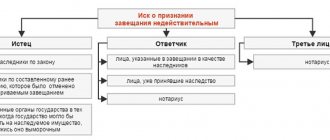Family Law > Parental Rights > How to prove paternity outside of marriage?
Marriage without official registration in the registry office, which is popularly called civil, remains quite common in 2021.
According to statistics, almost a third of all children are born out of wedlock, and their fate develops completely differently, depending on the relationship of the parents and the conscientiousness of the father.
How to establish paternity if the marriage is not registered? In this article we will look at what can be done to ensure that a child born in a civil marriage has all the rights of children born in a registered marriage.
Why establish paternity?
Paternity is the blood relationship between a child and a man (his father).
As a legal fact, it should be confirmed in the registry office with the corresponding birth record.
Establishing paternity is an act of civil status, therefore it is subject to state registration:
- If at the time of the child’s birth the mother and father were legally married, the mother’s husband is recorded as the father.
- If a child was born in a civil marriage, then paternity is established on the basis of an application submitted to the registry office, or through the court.
So, is paternity necessary to establish if a child is born out of wedlock?
Yes, because thanks to officially registered paternity, children born in a civil marriage will receive absolutely the same rights (including alimony) as those born in a legal marriage.
How to do it? How is paternity established outside of marriage?
The paternity of a person who is not married to the mother of the child born is established in the following ways:
- voluntarily (with mutual consent of mother and father);
- judicially.
Let's consider in which case one or another method of establishing paternity is required.
Who can register the fact of birth
Typically, a birth certificate is obtained from the mother or father of the child. But there are also situations when, for one reason or another, a newborn no longer has parents. Contrary to maternal instinct and sense of responsibility, some women do not pick up their children from the maternity hospital. It happens that the mother dies during childbirth, and the baby has no other relatives.
Obtaining a birth certificate
Fortunately, in the modern world there are fewer and fewer such situations, but the law provides for the procedure for obtaining a document in this case as well. In addition to the child’s parents, employees of the maternity institution can obtain a document confirming his birth. In addition, relatives of the child who are not his biological parents have the right to apply.
See also:
We solve the issue like a man: the child will be able to live with his father after a divorce
Registration of the fact of paternity, as well as obtaining a birth certificate, is carried out at the civil registry office. You can not contact any department, but only the one to which the house where the mother or father is registered belongs. Recently, it has become possible to submit an application through the Multifunctional Center. Sometimes people mistakenly contact the registry office where they registered their relationship. This is not true.
Father's consent
If the father agrees with his involvement in the birth of the child, and he recognizes it, then the procedure does not present any difficulty at all.
In order to recognize a child at will, without coercion, you will need:
- Collect a package of necessary documents.
- Contact the registry office together with the child’s mother.
- Write an application to establish paternity and make the necessary entries in the relevant papers.
The whole procedure is quite unpretentious and simple. At the same time, when applying to the registry office, the mother and father will not need to collect evidence of the existence of a biological relationship between the man and the baby.
To enroll the father in the birth certificate, you must provide the following documents with your application:
- Child's birth certificate.
- Identification card of both parents.
The application must be written on behalf of the man, filling out the standard application fields: the place of residence of both parents, their passport details, and a signature.
In this application, the common-law husband must indicate his agreement that he is the father of the child born.
In the application, you can indicate what surname the parents want to assign to the child. If it is not specified, then he will be assigned his father's surname.
With the consent of both spouses, he can be given his mother’s surname.
After all formalities are completed, parents will be given a birth certificate of the child, on which the father will be entered.
Perhaps this is the simplest method of establishing paternity without unnecessary bureaucratic formalities, of course, with the exception of official marriage.
Sometimes it happens that a father does not abandon his child, but for some reason he is unable to be present when his common-law wife is discharged from the maternity hospital.
In this case, he can draw up an application for acknowledgment of paternity together with his mother in advance.
If his absence was unplanned, for example, due to an urgent business trip, then there is also a way out in this situation: the father must submit an application through a power of attorney through his legal representatives or fill out the application correctly at a notary office, then certify it and send it by mail to his place of residence child with mother.
If, when issuing a birth certificate, the father was not included in it, then the child automatically takes on the mother’s surname.
Many mothers seek to establish paternity in hopes of receiving child support.
At the same time, they should take into account that alimony is calculated in the amount of 25% of the real salary of the child’s father, if the latter does not have other children in his care. If the father is unemployed, then alimony is assigned in a fixed amount.
If the child’s paternity is established, then his mother will not be considered a single mother, even if the father begins to evade paying child support.
Consequently, a woman who has established paternity in court will no longer have the benefits of a single mother.
At the same time, establishing paternity can be of great benefit for the child if the father receives a high salary - accordingly, the amount of alimony will also be high.
In addition, if the established father has property, then the child can count on receiving an inheritance after him (of course, if the property is preserved and is not bequeathed to other persons).
It is worth noting that in the case of a civil marriage and unestablished paternity, the child is deprived of both his father and paternal grandparents.
This means that they will not be able to leave an inheritance to their grandson, and the child has no right to claim it.
How to prove paternity outside of marriage if the father is against it
Today science makes it possible to determine the probability of relationship at the genetic level. The experiments carried out have an accuracy level of up to 99.5%. But experts as a result indicate the following:
- the possibility of paternity cannot be excluded;
- the likelihood of paternity is practically non-existent.
There are three ways to prove kinship:
- through the court;
- by conducting DNA research;
- thanks to material evidence of involvement in the birth and upbringing of the baby in a pre-trial manner.
All of these methods are worth considering.
Going to court
This measure is used if the biological father does not recognize his child. The judge decides to conduct a DNA examination in one of the accredited clinics. There are several circumstances that make it impossible to establish a relationship, despite a positive genetic test:
- the father was declared incompetent;
- the child has already been adopted;
- being in prison for committing serious crimes.
There is no need to contact the judicial authorities if the couple was in a civil marriage at the time of conception and birth of the baby, as well as if the birth took place within 300 days after the divorce or death of the spouse. He is automatically recognized as the father.
Most often, it is necessary to establish kinship in the event of the death of the mother or her recognition as incompetent, as well as in the case of a man’s obvious refusal to accept his child.
Procedure for going to court
This procedure must be strictly followed so that there are no grounds for refusing to consider the claim:
- filing a claim (it is best to contact a practicing lawyer who can implement this competently, in accordance with current requirements);
- provide a complete package of documents: a certificate of family composition, a child’s birth certificate, a receipt for payment of state fees, possible evidence of paternity and a copy of the claim to send to the defendant.
The application is considered within 5 days, after which a hearing date is set.
DNA examination and its cost
This research is carried out voluntarily or compulsorily. Almost anything can be used as a biological material.
However, experts recommend using saliva, sperm or blood.
If it is impossible to obtain this material, it is possible to take hair, skin remains and much more for analysis.
But then the cost of the study will be higher, since more labor-intensive tests are required.
You can submit material for study in person or by mail. To carry out the analysis you need:
- contact specialists from the laboratory of interest;
- sign a contract for the provision of services;
- make an advance payment or make a full payment (depending on the terms of the agreement);
- provide samples for examination;
- get the result.
Today, laboratories conduct double tests to eliminate errors. The average cost of a study is 20,000 rubles, but in some clinics it can be done for 12-14 thousand rubles.
Biomaterial of the potential father and child is required for analysis. If it is not possible to provide such samples, then it is possible for the parents of the child’s father to participate in the test.
Material evidence of involvement in the birth and upbringing of a child
Material evidence can serve as a powerful argument for recognizing paternity in court or pre-trial proceedings. Their presence often forces a man to resolve the issue out of court, since defeat in court entails additional costs.
Material evidence may include:
- an account statement showing that the potential father spent money on children's clothing;
- witness's testimonies;
- checks and receipts confirming payment for various goods and services for the child.
All this can serve as arguments in favor of the fact that the potential father takes part in the lives of the children, despite his reluctance to acknowledge them.
Establishing paternity in court
How to establish paternity in a civil marriage if the father is against his involvement in the birth of a new life, and therefore refuses to fulfill his duties in every possible way?
In this case, there is only one way out - you need to apply to the court with a petition.
Judicial practice shows that questions most often arise regarding the collection of evidence of kinship and establishment of paternity in the following cases:
- If a man does not want to become a father and pay child support obligations, despite recognizing the child as his own.
- In case a man does not recognize his relationship, believing that the child is not his daughter or son.
- The woman wants to limit the man’s influence on the baby, so she does not give the man the opportunity to communicate with him.
The complexity of the judicial determination directly depends on the existing situation.
How to prove paternity after the death of the father out of wedlock?
In such a situation, recognition of paternity is often necessary for the child to receive an inheritance and to assign pension payments for the loss of a breadwinner.
At the same time, it is no longer possible to conduct a DNA examination . Therefore, consideration of the evidence base and comparison of facts will take place in court.
If a woman dies, then it will be much easier to prove the relationship: you must provide evidence, and also obtain permission from the court to undergo a DNA test. Based on the results made by the laboratory, the court makes a verdict.
Registration of a child born in marriage: what documents are needed?
The newborn must be registered with the registry office within 30 days after birth. If the parents are legally married, any of them can apply to the department; the presence of the child is not required.
The following documents are collected for registration:
- a certificate from a medical institution confirming the birth of a live child;
- passport;
- Marriage certificate.
At the registry office, the parent attaches an application filled out in Form No. 1 to the documents provided. It contains the following information:
- name of the registry office department;
- Full name of the applicant;
- document's name;
- text informing about the birth of a son or daughter;
- a tabular form with personal information about each parent;
- parents' passport details;
- citizenship and nationality;
- place of registration of parents;
- basis for entering information about the father;
- The child’s full name is written below;
- date of compilation and signature.
We do not recommend completing the documents yourself. Save time - contact our lawyers by phone:
8 (800) 350-29-87
Based on the submitted documents, the registry office employees fill out the child’s birth certificate. Documents are processed and issued on the same day.
There are situations when a child is born some time after a divorce from a spouse or his death (how is paternity established after the death of the father?). In this case, the “300 days” rule applies. Children born within 300 days after these events are always registered with the ex-husband. To register a newborn, a standard package of documents and additionally a death or divorce certificate are provided. The 300 day report starts from the date specified in the document.
If the real father of the child is another man, he will have to prove his paternity through the court. The newborn will be registered under the name of the biological father only by a court decision; otherwise, he will be registered under the name of the ex-husband.
Statement of claim to determine paternity
Going to court requires thorough preparation. First of all, it is necessary to correctly draft the application to the court. How to properly file a claim to establish paternity and collect alimony without marriage in court?
In this case, it is worth visiting a lawyer or going to the court at your place of residence to correctly write the claim, following the sample.
The claim must indicate:
- Information about all parties involved in the process. This means both the court itself and the applicant and the defendant.
- Then you should provide complete information about the child: date and place of birth.
- Describe the situation in detail, indicating why it happened that the newborn did not automatically find a legal father.
- Provide compelling evidence to prove the relationship.
- Make a demand for justice.
- List the papers attached to the claim.
What papers should I provide? If you have documents confirming your rights, be sure to attach copies of them to your application:
- child's birth certificate;
- marriage certificate (if it was previously concluded with the baby’s father);
- copy of passport;
- father's death certificate;
- registration certificate;
- certificate 2-NDFL (for mothers who are officially employed);
- a check or receipt for payment of the mandatory payment for filing a claim.
The claim must be signed by the applicant and submitted to the secretariat for registration.
If the child is already 18 years old at the time of the hearing, he can file a claim on his own. This is relevant in cases where he claims to receive an inheritance.
Until adulthood, the child’s rights can be defended by the second parent or guardian.
How to establish paternity if the marriage is not registered

None of the relationship options restricts the father’s right to voluntarily acknowledge paternity.
The best way to officially confirm that a man is the father of a child is to obtain his consent.
The registry office at the place of residence of either parent will accept the application and confirm the applicant’s status.
When an agreement cannot be reached, the opportunity to confirm paternity is provided based on a court decision.
Through the court
The courts may be contacted by:

- a mother to recognize a specific person as the father of her child if that person shirks his responsibilities;
- the father, when the mother, the guardianship authorities prevent the registration authorities from making an entry;
- guardian who is responsible for the minor;
- child turning 18 years old.
During the trial, any evidence certifying the relationship is accepted and taken into account (Article 55 of the Civil Procedure Code of the Russian Federation).
To appeal to the court on this issue you need:

- prepare a statement of claim;
- provide a birth certificate;
- pay the mandatory tax;
- take care of the evidence.
The court will schedule hearings, hold meetings, and consider evidence.
At the request of the plaintiff, a genetic examination may be carried out.
Once the claim is satisfied, the court will make a decision. Based on it, the registry office staff will make an entry and issue a certificate.
At the registry office

The procedure for issuing a document at the civil registry office, if there are no disputes, proceeds quite quickly.
Parents:
- fill out an application;
- provide the required package of documents;
- pay the state fee;
- receive a certificate in hand on the day of application.
The legislation allows you to submit a corresponding application during pregnancy, when the child is not yet born, if life circumstances recommend starting the process of registering the application in advance. The action will finally end after the child is born (Article 48, paragraph 3, IC).
A citizen claiming paternity rights can independently submit an application on his own behalf to the registry office. The legislator stipulates this possibility in certain situations:
- death of mother;
- her incapacity;
- deprivation of parental rights.
What evidence should I provide?
The plaintiff must prove his relationship in court. The defendant, by law, does not need to justify himself, although he has the right to defend his interests by presenting counterarguments.
How to prove through court that a common-law husband is the biological father of a child? The evidence base can be:
- Availability of witnesses. The circle of witnesses is actually quite large. These could be neighbors, acquaintances, relatives, or strangers. Social workers or hospital medical staff can provide the necessary evidence.
- Coincidence of surname and patronymic (even according to the mother).
- Letters, receipts for receiving various parcels.
- Receipts and checks for postal and bank transfers.
- Certificate of family composition (if the child and both parents are registered at the same address).
- Joint family photos.
- Excerpts from the medical record (of the child or parents), the birth history of the woman in labor.
- Audio recordings, SMS correspondence, filmed videos - everything that shows the existence of a relationship between parents.
Today, the main evidence is DNA testing. However, it should only be established at the request of the court, since genetic testing done independently is not recognized in court.
How to prove paternity out of wedlock if the father is against DNA? Of course, the defendant may well refuse to perform such an examination, since the evidence may serve as recognition of the fact of relationship.
Although no one has the right to force him, the mother should not be upset - the court will consider other evidentiary facts.
Obtaining a certificate
Proven paternity must be confirmed through an issued certificate.
To obtain a certificate, the plaintiff will need:
- Obtain a written copy of the court order.
- Take the baby's birth certificate and your passport.
- Pay the required state fee.
- Come to the registry office.
- Fill out an application for the issuance of the appropriate form.
The result of these actions will be the receipt of a certificate of paternity and the entry of new information into the civil register.
Video: Establishing paternity
Download:
Claim to establish paternity and collect alimony without marriage - Sample.doc
Similar articles:
- The procedure for establishing paternity at the registry office
- DNA paternity test
- Responsibilities of parents to children
- What does improper performance of parental responsibilities mean?
- Responsibilities of godparents
- Previous entry Certificate of paternity
- Next entry What is surrogacy and the cost of the service
Comments on the article “How to prove paternity outside of marriage?”
Nobody has written anything yet. Be the first!
How to recognize involvement in the origin of a child born out of wedlock?
Registration of paternity is carried out by the Civil Registry Office after submitting an application and all required documentation. In this case, there must be a joint decision of the father, mother and, if necessary, the child. In order for the procedure to go smoothly, you need to know how to write a petition correctly and what to attach to it.
The certificate is issued at the civil registry office: at the place where the child’s birth certificate was issued, at the place of registration of one of the parents, or at the location of the court that recognized paternity.
Sample application
There are two forms of application to the registry office, which are approved by Decree of the Government of the Russian Federation of October 31, 1998 No. 1274. Form No. 12 is filled out by a couple whose marriage is not registered, and form No. 13 is intended for a man whose wife has died.
In both cases, the document has the same structure. In it, the citizen must declare in writing that he recognizes himself as the father of the child (indicating his full name, date and place of birth, gender)
It is also important to write that the woman (mother) recognizes the applicant as such

At the end of the text the following is written:
- personal information of both parents based on identity documents;
- child’s preferred data: last name, first name, patronymic and nationality;
- list of attached documents;
- date of preparation and signature of the applicant.
You can submit documents to the mother and father together, separately or by mail (in which case the application and consent must be notarized).
After receiving the package of documents, the government agency is obliged to accept it (if the applicants did not make mistakes) and within 1 month make the appropriate registration entry in the birth register. The procedure is completed by changing the child’s data in his birth certificate or issuing a new document (at the joint request of the mother and father).
A sample application to establish paternity at the registry office can be downloaded here.
What documents are needed for registration?
To confirm the necessary circumstances of the case, in addition to the application, the registry office requires:
- passports of men and women;
- the child’s birth certificate (if it was issued before filing the application);
- a certificate from the maternity hospital confirming the birth of the baby (at the time of initial registration);
- a check in the established amount of state duty;
- consent of an adult son or daughter, if paternity has not been established before the application.
The sole submission of an application by a man must additionally be accompanied by a correctly executed permission from the guardianship authority and a positive judicial act. The package of documents should absolutely not contain a power of attorney to represent interests, since the applicant is obliged to personally fill out a petition to establish his parental rights and submit papers to the registry office.
Otherwise, the government agency will refuse to accept the application. Even a notarized power of attorney has no legal force in this situation.
Expert opinion Maria Lokshina Family law expert since 2010
The mother’s personal presence is not necessary; it is enough to obtain her written consent to register paternity, certified by a notary.
Amount and methods of payment of state duty

A receipt confirming payment of the state fee is an integral document attached to the application for paternity.
As part of this procedure, you must pay for a form of the child’s birth certificate and making an entry in the registration book.
The amount of the duty is determined by Article 333.26 of the Tax Code of the Russian Federation, and details for its payment can be found on the website of the Federal Tax Service.
For establishing paternity without issuing a new certificate, it will be 350 rubles, since changes will be made to the existing document. If parents wish to receive a new form, they will have to pay 650 rubles to the state treasury.
Obtaining a child's birth certificate

When paternity is established by application from both parents at once, together with the registration of the child’s birth, the certificate is usually issued by the registry office on the day of the application.
When sending an application during a woman's pregnancy, a new application from the man will not be required. A record of the child’s parents is made within a month after the birth, when it is registered.
In this case, the birth certificate is issued free of charge, that is, there is no need to pay a state fee. If the child in respect of whom the relationship of a man is established has reached the age of majority, he independently receives a new certificate. It should be recalled that recognition of paternity in this case is possible with the written consent of the child.








